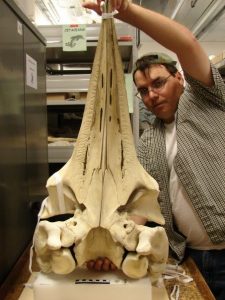Morgan Churchill, Ph.D.
Assistant Professor
Office: HS159
Lab: HS146
Phone: (920) 424-4622
Email: churchim@uwosh.edu
Education and Training
- PhD – Ecology, University of Wyoming (2014)
- M.S. – Biology, San Diego State University (2007)
- B.S. – Zoology, Michigan State University (2003)
Courses Taught
- BIO 211 Human Anatomy – Lecture and Lab
- BIO212 Human Physiology – Lab
Research Interests
Marine environments are food-rich and provide a way for land-dwelling animals to escape competition with terrestrial predators. However, the invasion of aquatic environments necessitates dramatic changes in locomotion, thermoregulation, and reproduction for terrestrial organisms. Despite the challenges oceanic environments create for terrestrial animals, over the last 250 million years, a variety of organisms have invaded marine habitats. These secondarily aquatic animals include such disparate organisms as ichthyosaurs, plesiosaurs, sea turtles, whales, seals, and penguins.
 My primary research focus in our lab is exploration of the ecological and morphological changes associated with the transition from terrestrial to aquatic environments. By comparing the anatomy, behavior, and ecological changes that different organisms use to adapt to aquatic environments, new insights can be made on the factors that allow terrestrial animals to invade marine environments and development of key morphological innovations that lead to adaptive radiations within aquatic tetrapods.
My primary research focus in our lab is exploration of the ecological and morphological changes associated with the transition from terrestrial to aquatic environments. By comparing the anatomy, behavior, and ecological changes that different organisms use to adapt to aquatic environments, new insights can be made on the factors that allow terrestrial animals to invade marine environments and development of key morphological innovations that lead to adaptive radiations within aquatic tetrapods.
The main study organisms we work on in my lab are marine mammals, in particular pinnipeds (seals, sea lions, and walruses) and cetaceans (whales). Pinnipeds are unique among marine mammals in that, unlike sea cows or whales, they must still return to aerial environments for reproduction and molting. Understanding the reasons why pinnipeds still maintain terrestrial breeding when other marine mammals have become fully adapted for aquatic reproduction may provide us information on biological constraints to aquatic adaptations and the influences of oceanic productivity and climate on the land-to-sea transition.
In contrast, whales are fully aquatic, with the largest diversity of any marine mammal group. This diversity is enhanced by a suite of unique ecological and morphological adaptations that allow whales to exploit marine environments, ranging from specialized filter feeding in baleen whales (Mysticeti) to echolocation in toothed whales (Odontoceti). Whales have an excellent fossil record making them icons of evolution, and my research on whales focuses on examining how there morphology over time has adapted to an aquatic lifestyle, and how changes in morphology influence diversity and evolution in the group.
Research in my lab has three main focus areas:
Phylogeny
To understand the evolutionary adaptations marine mammals develop to an aquatic environment, knowledge of the evolutionary relationships of different species to one another is needed. A major part of the research performed in my lab is interpreting the phylogenetic relationships of marine mammals, using anatomic and combined evidence approaches within a cladistic framework, as well as incorporating data from the fossil record. Past research has focused on interpreting the phylogeny of right whales (Mysticeti: Balaenidae), and current ongoing research is focused on the phylogeny of Pinnipedia and early odontocete whales.
Functional Anatomy
In transitioning to aquatic environments, mammals had to undergo dramatic changes in morphology. Research in my lab chronicles the record of these changes and how they have influenced the diversity and ecology of these animals through time. Much of this research incorporates morphometric analyses of measurement and landmark data, to determine the principal sources of variation in morphology, as well as identify the functional and ecological significance of this variation. Ongoing research focuses on the evolution of skull shape and hearing ability in whales and pinnipeds.
Paleoecology
Reconstructing changes in ecology is critical in understanding the evolution of aquatic tetrapods. Our lab employs a variety of approaches to reconstruct the paleoecology of fossil organisms, integrating traditional morphological proxies for diet or behavior with stable isotope analysis and morphometrics. Current ongoing research is focused on examining the utility of various morphological characteristics, including body size, limb bone shape, rostrum length, temporal fossa size, and orbit diameter, to predict the ecology and lifestyle of fossil whales.
Selected Publications
Churchill, M. and Baltz, C*. 2021. The evolution of orbit size in whales (Artiodactyla: Odontoceti). The Journal of Anatomy. https://doi.org/10.1111/joa.13522
R.W. Boessenecker, and M. Churchill. 2021 The surprising evolutionary heritage of the modern walrus as chronicled by the fossil record. In The Atlantic Walrus: Biological, Historical, and Indigenous Insights into the Species-Human Interactions, Eds. Weber, X., Olsen, M.T., Jordan, P., and Desjardins, S.P.A. 2021. Elsevier Press.
Boessenecker, R.W., M. Churchill, E. Buchholtz, B.L. Beatty, J.H. Geisler. 2020 Reappraisal of “Squalodon” tiedemani and the postcranial evolution of early odontocetes. 2020. Current Biology. 30:1-7.
Coombs, E.J.*, Clavel, J., Park, T., M. Churchill, A. Goswami. 2020. Wonky whales: the evolution of cranial asymmetry in cetaceans. BMC Biology.18:1-25. https://doi.org/10.1186/s12915-020-00805-4
Churchill, M. and Uhen, M.D. 2019. Taxonomic implications of morphometric analysis of earless seal (Carnivora: Phocidae) limb bones. Acta Palaeontological Polonica 64. https://doi.org/10.4202/app.00607
Boessenecker, R.W., Ehret, D.J., Long, D.J., Churchill, M., Martin, E., and Boessenecker, S.J., 2019. The Early Pliocene extinction of the mega-toothed shark Otodus megalodon: a view from the eastern North Pacific. PeerJ 7:e6088. https://doi.org/10.7717/peerj.6088
Churchill, M., Miguel, J., Beatty, B.L., Goswami, A., and Geisler, J.H. 2018. Asymmetry drives modularity of the skull in the common dolphin (Delphinus delphis). Biological Journal of the Linnean Society. 126:225-239.
Churchill, M., Geisler, J.H, Beatty, B.L., and Goswami, A. 2018. The evolution of cranial telescoping in toothed whales (Odontoceti). Evolution. 72:1092-1108
Berta, A., Churchill, M., and Boessenecker, R.W. 2018. Evolution of seals, sea lions, and walruses. Annual Review of Earth and Planetary Sciences. 46:203-228
Boessenecker, R.W. and Churchill, M. 2018. The last of the desmatophocid seals: a new species of Allodesmus from the upper Miocene of Washington, USA. Zoological Journal of the Linnean Society. XX:1-25.
Boessenecker, R.W., Fraser, D., Churchill, M., Geisler, J.H. 2017. A toothless dwarf dolphin (Odontoceti: Xenorophidae) from the Oligocene of South Carolina points to explosive feeding diversification of modern whales. Proceedings of the Royal Society B. 284:20170531
Churchill, M., Martinez, M.R, Muizon, C., Mnieckowski, J. and Geisler, J.H. 2016. The origins of high frequency hearing in whales. Current Biology. 26:2144-2149.
Churchill, M. and Boessenecker, R.W. 2016. Taxonomy and biogeography of the Pleistocene New Zealand sea lion Neophoca palatina (Carnivora: Otariidae) Journal of Paleontology. 90:375-388.
Churchill, M. and Clementz, M.T. 2016. The evolution of aquatic feeding in seals: Insights from Enaliarctos (Carnivora: Pinnipedimorpha), the oldest known seal. Journal of Evolutionary Biology. 29:319-34.
Boessenecker, R.W. and Churchill, M. 2015. The oldest known fur seal (Mammalia: Carnivora). Biology Letters. 11:20140835.
Churchill, M. and Clementz, M.T. 2015. Functional implications of variation in tooth spacing and size in Pinnipedimorpha (Mammalia: Carnivora). The Anatomical Record. 298:878-902.
Churchill, M., Clementz, M.T., and Kohno, N. 2014. Cope’s rule and the evolution of body size in Pinnipedimorpha (Mammalia: Carnivora). Evolution. 69:201-215.
Churchill, M., Boessenecker, R.W., and Clementz, M.T. 2014. The Late Miocene colonization of the Southern Hemisphere by fur seals and sea lions (Carnivora: Otariidae). Zoological Journal of the Linnean Society. 172:200-225.
Boessenecker, R.W., and Churchill, M. 2013. A reevaluation of the morphology, paleoecology, and phylogenetic relationships of the enigmatic walrus Pelagiarctos. PLOS One 8(1):e54311.
Churchill, M., Deméré, T, and Berta, A. 2011. The systematics of right whales (Mysticeti: Balaenidae). Marine Mammal Science. 28:497-521.
Berta, A., and Churchill, M. 2011. Pinniped taxonomy: review of the evidence used for description of currently recognized species and subspecies. Mammal Review. 42:207-234.
